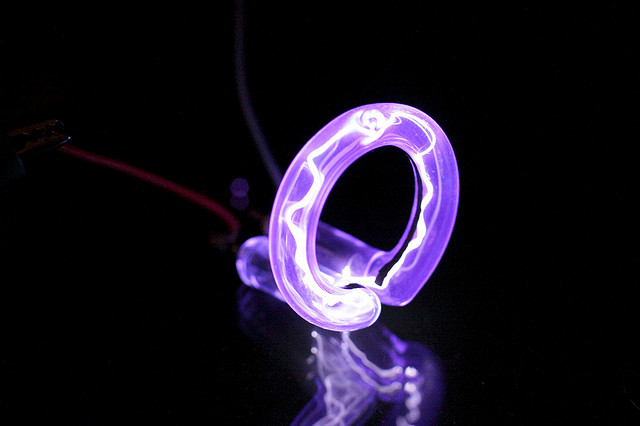
Xenon gas has been in the sports news since this winter, when it was revealed that Russian skiers had been breathing the gas to increase the oxygen-carrying capacity of their blood. It caused something of an uproar, but only a quiet one because people were confused: what exactly is going on here? Isn’t xenon a noble gas that has a purplish spectra? Regardless of whether it makes you faster, why would you breathe that? Should we be outraged?
Xenon has many properties which have been used in relation to medical fields for decades. It’s an anesthetic which will soon be introduced to broader use in Europe, in part because it is more potent and thus requires a lower proportion in the bloodstream in comparison to commonly-used N2O. It’s also a neuroprotectant, and clinical trials are being developed to determine whether breathing xenon gas when the body is oxygen-starved (or recovering from such a state) can help prevent brain damage.
In the doping context, breathing xenon leads to a series of steps which may increase athletic performance. First, the presence of xenon increases the production of a transcription factor (HIF1A) – a protein which binds to a specific region of our DNA. This transcription factor codes for a protein which is usually produced only in low-oxygen, hypoxic environments. This in turn boosts erythropoietin levels, so that the blood can carry more oxygen: an obvious benefit for endurance athletes.
Yet very little research has confirmed that this actually translates into athletic improvement. One of the only studies ever published on the topic of using xenon in a training regime is in Russian, and thus inaccessible to most of the rest of the world.
So despite the perplexed look on everyone’s faces when the Russian xenon-huffing scandal broke, most were quick to condemn the practice. In fact, some argued that it might already be breaking the World Anti-Doping Agency (WADA) code. Although xenon was not, at that point, expressly banned, the following sentence described prohibited methods. It’s banned to:
“Artificially enhancing the uptake, transport or delivery of oxygen, including, but not limited to, perfluorochemicals, efaproxiral (RSR13) and modified haemoglobin products (e.g. haemoglobin-based blood substitutes, microencapsulated haemoglobin products), excluding supplemental oxygen.”
Since breathing xenon does artificially enhance the uptake of oxygen, it seemed like a slam dunk. Former WADA president Dick Pound told the German news service WDR, which was doing an investigation into xenon as a performance-enhancing drug, that he was “in no doubt that it is doping.”
The team doctor for the Garmin-Sharp cycling team said that his team had considered using xenon, but decided not to because it was potentially dangerous and, they had concluded, definitely illegal. And cycling teams aren’t usually the most trustworthy people on doping issues.
But WADA was quiet until it added an amendment this spring expressly banning xenon (and argon, a neighbor on the periodic table) in no uncertain terms.
Now, scientists have been trying to develop a test to detect the use of xenon. Writing in Rapid Communications in Mass Spectroscopy, a team from Cologne and Düsseldorf, Germany, report on a new test that seems to be working.
The team used a combination of techniques including gas chromatography and mass spectroscopy, accounting for the specific mass of three different xenon isotopes, to detect xenon concentrations in the blood. In the first part of their trials, they fortified blood plasma with xenon to specific concentrations, and then tested whether their method could detect it.
With that success under their belt, they moved on to realistic human trials. Their subject was a woman who was undergoing anesthesia using xenon gas. The team collected blood samples during the anesthesia as well as 4, 8, and 24 hours afterwards, and then ran the samples through their test – sometimes after storing them for up to 36 hours. Even the samples collected 24 hours after the anesthesia had xenon detected by the team’s test.
The team writes that the application of the test for antidoping purposes is not necessarily a slam dunk. From reports, for instance, athletes might breathe xenon through a mask for just a few minutes, which is different from the amount of the gas which might be taken in during anesthesia – and potentially harder to detect. It’s also unclear whether samples taken further after breathing xenon would still show detectable signs of the gas.
But it’s a first step towards testing for the use of this newly-banned substance.
“… accredited laboratories are in need of adequate detection assays, and the pilot study presented in this communication demonstrated the suitability of conventional [athlete biological passport] doping control samples for detecting the anesthetic substance by commonly available GC/MS (or HRMS) instruments,” the authors conclude. “Further studies are required to allow the assessment of detection windows for xenon under different gas mixture and exposure time settings.”
Chelsea Little
Chelsea Little is FasterSkier's Editor-At-Large. A former racer at Ford Sayre, Dartmouth College and the Craftsbury Green Racing Project, she is a PhD candidate in aquatic ecology in the @Altermatt_lab at Eawag, the Swiss Federal Institute of Aquatic Science and Technology in Zurich, Switzerland. You can follow her on twitter @ChelskiLittle.



